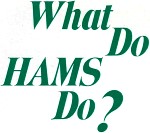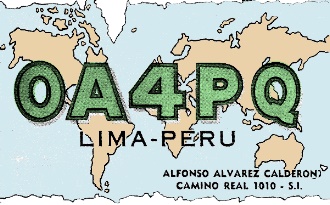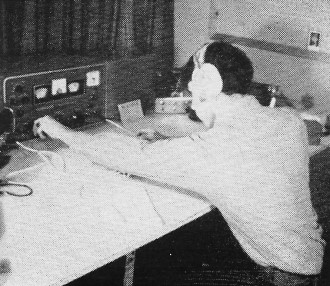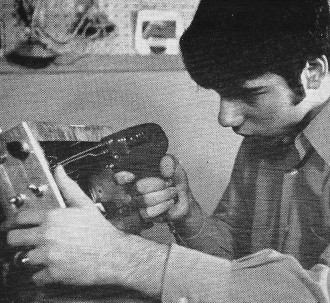|
March 1972 Popular Electronics
 Table of Contents
Table of Contents
Wax nostalgic about and learn from the history of early electronics. See articles
from
Popular Electronics,
published October 1954 - April 1985. All copyrights are hereby acknowledged.
|
Often times, a recent convert,
adopter, proselyte, or whatever name you give to a newly energized person who has
a new activity or lifestyle, is among the most ardent of disciples for that realm.
That goes for religions, weight loss and smoking cessation programs, social and
political movements, and even hobbies. Recipients of that person's enthusiastic
dogma view such evangelism as anything from welcome news worthy of adoption to merely
annoying to downright offensive and unbearable. Since receiving my first Amateur
Radio operator's license in 2010, long-time visitors of RF Cafe have probably noticed
an increase in the number of Ham-related news stories and magazine articles on the
subject. Hopefully, my interspersing them with more career-centric engineering and
technical content is not regarded as superfluous to non-Hams. The fact is that even
if you have no interest in becoming an Amateur Radio operator, the incredible amount
of information generated by the Ham community - which consists in a large part of
electronics engineers and technicians - is beneficial to the majority of people
in the professional field. So, if you think I have gone overboard with Amateur Radio
content, I encourage you to do a little investigation into how valuable the craft
is; you might even find yourself ordering a Technician class study manual.
What Do Hams Do?
By Don Waters
 Do you want to be a ham? You can join a net,
enter amateur contests, build and operate equipment, or DX on your own. Do you want to be a ham? You can join a net,
enter amateur contests, build and operate equipment, or DX on your own.
W1EFW, WAIJVV, and WA1NIO are all "traffic handlers" (that is, they provide a
channel via amateur radio for the transmission of messages) - in varying degrees
and for different reasons. W1EFW is a bank president and a long-time ham who has
had military communications experience and who now thoroughly enjoys regular participation
in organized, scheduled "net" activity. WA1JVV and WA1NIO are both young high-school
students; WA1JVV is proud of the recognition he has received for his traffic handling
and enjoys the service aspect; WA1NIO is still limited by the capabilities of his
"rig" or station and finds it easy to get onto a net whenever he wants to get on
the air.

One of the attractive QSL cards among the many which hams exchange
after contacts. This elaborate card is printed in blue and yellow with bold orange
letters.

Common denominator of amateur radio is direct communications
between hams across town or around the world. This is "people-to-people" communications
at its best, with no barriers.
There are many different kinds of nets in amateur radio - ranging from thoroughly
organized cross-country and regional nets, all tied together and with regular schedules
for operations and training for emergency conditions, to local, good-fellowship
nets with no formal purpose. As amateur radio has grown in numbers, in technology,
and in sophistication, interests have become diversified; various activities have
developed - each with its particular adherents. Traffic handling is one such specialty.
Contests are another, and these run the gamut of both proficiency required and
scope. One of the best known contests is Field Day (sponsored by the American Radio
Relay League. or ARRL) conducted once a year in June. Individual hams and especially
local radio clubs as a group set up portable equipment, including portable generators,
in the field and operate under simulated emergency conditions for a weekend, attempting
to log as many contacts as possible. Another contest is the ARRL-sponsored Sweepstakes
which is primarily on an individual basis - there is even a Novice Round-up for
beginners. Various worldwide organizations in the ham field conduct their own specialized
contests. In just about all cases the competitive spirit is at a fever pitch.
Another specialty whose adherents are among the most avid ham operators is DX
or distant contacts. Protagonists try to make verified contacts with other hams
in as many different countries and remote locations as possible. Verification following
a contact is in the form of an exchange of QSL cards, post-card size, with imaginative,
often very colorful designs. Every ham has his own personal QSL card and as a recipient
of others may collect thousands of different ones over the years.
There is a DXCC-DX Century Club - in which a ham who has verified contacts with
a hundred or more different "countries" (by amateur radio definition) receives an
appropriate certificate. He gets endorsements for additional increments up to the
350 or so recognized "countries."
Most hams will "chase DX" to some extent, given the right conditions and the
opportunity, but the true DXer is a special breed. Only a completely hooked type,
for example, would actually mount an expedition - via ship or any other means-to
some remote coral reef or uninhabited island in the middle of an ocean just to set
up a portable station, go on the air, and originate QSL cards from another rare
spot. This is called a DXpedition, and they take place all the time and practically
all around the world.
Operating in Other Countries
If you are a world traveler, the United States and the following countries have
negotiated bilateral agreements permitting their licensed amateurs to operate in
each other's country. As a courtesy, a number of other countries grant temporary
permission to U.S. (and other) amateurs to operate within their borders. Getting
the necessary permission to operate in any of these countries usually involves filling
out a simple form and furnishing a photocopy of your current U. S. amateur license.
Allow plenty of time for the wheels to turn. Specific information on any country
can usually be obtained upon request (with a stamped return envelope) from ARRL,
225 Main St., Newington, Conn. 06111. A query to the country's nearest consulate
is also productive, but may be slower.
|
Argentina
Australia
Austria
Barbados
Belgium
Bolivia
Brazil
Canada
Chile
Colombia
Costa Rica
Dominican
Republic
Ecuador
El Salvador
|
Finland
France*
Fed. Rep.
Germany
Guatemala
Guyana
Honduras
India
Indonesia
Ireland
Israel
Jamaica
Kuwait
Luxembourg
Monaco
Netherlands*
|
New Zealand
Nicaragua
Norway
Panama
Paraguay
Peru
Portugal
Sierre Leone
Sweden
Switzerland
Trinidad
& Tobago
United Kingdom*
Uruguay
Venezuela
|
*Includes overseas entities
Many hams are builders, tinkerers, or experimenters. In the earliest days an
amateur had to build his own equipment. Since World War II, however, commercially
built amateur radio gear of all kinds and in a wide range of prices has appeared
on the market. This is now a large market in itself, but there is still a special
fascination and pride in doing it yourself. The term "home brew" is used to describe
transmitters, receivers, and other gear constructed by the amateur. Even hams who
do not want to tackle a major piece of equipment enjoy putting together simpler,
auxiliary gadgets. Others actually get more pleasure out of construction or experimental
projects than they do out of being on the air. Experimenters especially like to
work with v.h.f. (very high frequency) equipment, FM, radio teletypewriter, and
- particularly - amateur television.
To the vast majority of amateurs a favorite activity is still, as it always has
been, "rag chewing," just getting on the air and talking to anyone. It may be an
old friend or a brand-new contact; a ham around the corner or across the world.
K1CC has had regular, scheduled weekly "talks" for more than 30 years with friends
in Australia and New Zealand - and with his sister 500 miles away - all via cw or
code; he has little use for new-fangled phone!
"Rag chewing" is really the common denominator, the staple among all radio amateurs.
The visitor to any ham's "shack," as he calls it, is usually impressed most of
all by the array of seemingly complex electronic gear. He will also notice various
objects hung or posted on the wall. Among them unfailingly will be an assortment
of certificates, for hams are collectors too. There are certificates representing
awards: WAS or Worked All States, WAC or Worked All Continents (awarded by the International
Amateur Radio Union), Code Proficiency, and even RCC-Rag Chewers Club. Others may
signify appointments in amateur radio field organizations - Official Observer, Official
Bulletin Station, and many more. (Those referred to are issued by ARRL.)
Among the more exotic specialties engaged in by hams is the OSCAR (Orbiting Satellite
Carrying Amateur Radio) program. To date hams have built five OSCARS which have
been launched into space as hitchhikers on Air Force and NASA vehicles. These are
communications satellites. OSCAR V was an international project, built in Australia,
launched in the United States, and monitored by amateurs around the world. Reports
were received from several hundred stations in at least 27 countries, including
the Soviet Union. Under the direction of AMSAT, the Radio Amateur Satellite Corporation
(a non-profit group), the OSCAR program is proceeding vigorously with even more
ambitious projects in the future.
One of the first hams to bounce a radio signal off the moon was also an Australian,
Ray Naughton, owner of a radio-TV-farm appliance store in the small village of Birchip,
Australia. His moonbounce signal made history in 1966 when it was received at an
amateur station in Crawford Hill, New Jersey.

One of the many satisfactions found in amateur radio is "do it
yourself." It may be a major construction project, experimenting with new gear,
or just putting together some piece of auxiliary equipment for your old rig.
A unique public-service activity by hams is Project MED-AID, a daily shortwave
medical emergency service, operated by the Duke University Medical Center Amateur
Radio Club in Durham, North Carolina. Since it went on the air in August 1966, it
has often provided dramatic on-the-air medical advice and assistance to remote outposts
in Central America, South America, and Africa. The MED-AID station bears the call
letters, WB4BLK. In one case, a 10-year old boy, victim of a head injury, lay in
a small Nicaraguan hospital with a severe concussion and signs of mounting pressure
inside his skull. But brain surgery was a dangerous gamble in this remote hospital.
The risk was minimized, and the outcome successful, after the local doctors were
able to get rapid consultation with medical specialists thousands of miles away
via MED-AID.
Radio amateurs provided communications for many early exploratory expeditions.
In 1923, for example, an amateur named Donald Mix, now WITS, accompanied Captain
Donald B. MacMillan aboard the schooner "Bowdoin" on his Arctic Expedition. Mix's
station, WNP - "Wireless North Pole" - kept the world informed of the expedition's
progress and provided outside contact for the crew. The dirigible "Shenandoah" carried
amateur radio equipment. Communications for then-Commander Richard E. Byrd's first
Arctic expedition were furnished by amateurs, again on his first Antarctic expedition
in 1928, and on later voyages as well.
MARS (the Military Affiliate Radio System) is an organization in each of the
three armed services - Army, Navy/Marine Corps and Air Force - composed of civilian
radio amateurs who assist the services by providing morale communications between
servicemen overseas and aboard ships around the world and their families back home,
and by providing a communications reserve. In the process they also acquire valuable
training. MARS operates in frequency bands outside the regular amateur bands. Perhaps
the best known MARS operation is Senator Barry Goldwater's station in Arizona which
is manned around the clock by a group of volunteer amateurs handling morale messages
primarily to Vietnam.
Third-Party Messages
International regulations forbid radio communications in behalf of "third parties"
via amateur radio unless special arrangements have been made by the individual governments.
The United States has negotiated agreements with the countries listed below to permit
"unimportant" third-party messages to be exchanged. Most of the agreements also
permit "emergency" messages to be exchanged-if the emergency messages are transferred
from amateur to commercial channels as soon as possible.
|
Argentina
Barbados*
Bolivia
Brazil
Canada
Chile
Colombia
Costa Rica
Cuba
|
Dominican
Republic
Ecuador
El Salvador
Greenland**
Haiti
Honduras
Israel
|
Liberia
Mexico
Nicaragua
Panama
Paraguay
Peru
Uruguay
Venezuela
|
*U.S. stations operating "portable 8P"
**XP calls only
Many amateurs have equipped their automobiles with compact two-way units which
not only enable them to enjoy on-the-air activity while traveling but can be, and
often have been invaluable in time of communications emergency. To anyone riding
for the first time with W1PQ in his radio-equipped Volkswagen bus, the experience
may be a bit disconcerting as Rog casually taps out and receives Morse Code messages
in transit!
Ham radio is often a family affair. A somewhat unusual example is husband WA1NHN,
wife WA1NHL, and their children WA1NHJ, WA1NHM, and WA1NHK. If bathrooms can be
a scramble for some families, imagine the congestion in this family if everyone
wanted to go on the air at the same time!
There are more than 2000 amateur radio clubs across the country organized by
local hams with a common interest, high schools, or other community groups. About
1300 of these are affiliated with the American Radio Relay League which gives them
access to an extensive training-aids library of films and other material. Many of
these clubs conduct regularly scheduled code and theory classes for newcomers; others
operate club stations, have periodic auction of ham gear, participate as a group
in contests like Field Day, publish club newsletters, and offer good fellowship
among people with a common interest.
Hams also enjoy conventions and "ham-fests." Every year there are numerous regional
and usually one national convention held by ARRL and other organizations. Here hams
attend sessions on technological developments and operating activities, enjoy banquets
and other social activities, and explore exhibits by commercial equipment manufacturers
and amateur radio suppliers.
Posted October 32, 2023
(updated from original
post on 11/9/2017)
|









 Do you want to be a ham? You can join a net,
enter amateur contests, build and operate equipment, or DX on your own.
Do you want to be a ham? You can join a net,
enter amateur contests, build and operate equipment, or DX on your own. 


